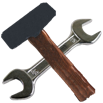First of all, before laying laminate with their hands to prepare the floor. It must be smooth and without large fluctuations should not "walk." Ideally we should perestilat floor and make it out of plywood with a minimum thickness of 22 mm, the distance between joists 500 mm. May be placed on top of linoleum, wood flooring or coated subject flatness. Not recommended laying on top of carpet due to static electricity. When laying on the concrete floor moisture latter should be within 2.5%. Laminate flooring is not recommended to be laid in wet areas (bath, sauna).
Before
Before embarking on laying laminate flooring it is necessary to keep in the room for at least two days at a constant room temperature and humidity. This is necessary to equalize the moisture content to prevent further shrinkage or swelling.

Before laying encouraged to review the rules, which are inside the package.
Tools Required
Self laying laminate you will need: a hammer, a short block (for podstukivaniya lamellas), jigsaw, wedges, clamps Z-shaped (for extreme styling panels), a pencil with a ruler, tape for vapor barrier concrete base, sound absorbing substrate.
Laying
Laminate flooring to be installed in a floating manner. That is the panel in any case should not be rigidly fixed to the base (nails, screws, glue, etc.). The panels must be oriented parallel to the incident light. If this rule is not observed, the stitches will be highly visible and will spoil the picture. When laying on the ground, having a heater, you should pay attention to the fact that water has to be heated, as rapid heating of the laminate can cause damage (formation of cracks).
When laying on a concrete foundation for sound-absorbing substrate to lay a vapor-proof film. It will protect the laminate on the residual moisture concrete. When laying on the linoleum or wood vapor barrier is required.
Where to start packing?
Laying laminate with their hands should begin to build a base number of the two boards. When installing the base number immediately set wedges between the wall and the first row of fins. The gap should be between 7-15 mm. Clearances are required to compensate for increasing the amount of moisture. To facilitate installation, fit the lock on the panel itself. After the formation of the base number, you are ready to install the next. The panels must be laid with a shift poldoski (that is on top, like he is in a half-brick masonry). This will distribute the stresses in humid expansion. Panel of the second row is moved to the lock at an angle, then it is inserted into the lock and snapped. Mechanical locks have not yet joined. Then, the formation of the second row, and when typed 4.3 bar, snap all Mechanical locks, urging them to each other. After installation of the second row, in the same way the rest of the series should be laid. For mounting the extreme boards (which are adjacent to the wall) using clamp, which will greatly facilitate the mounting latch locks.
If the laminate surface, cover the large area, then the length or width of the cover of more than 12 meters should provide the joints with a minimum width of 12 mm.
When laying laminate should pay attention to the gap between the door and the floor. This gap must be at least 10 mm. It is to avoid problems with the door open. Even if the door is a little touch of laminate, it then traces remain. To frequently move around the furniture needs to stick felt pads on the legs. After completing the installation mounted plinth, which will give a complete view of the whole picture.
 Full-Repair.com
Full-Repair.com